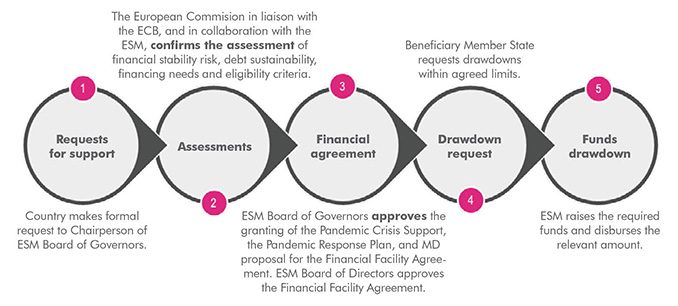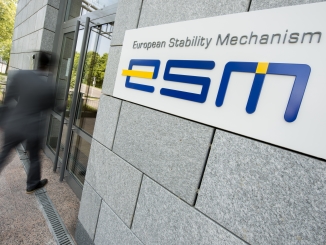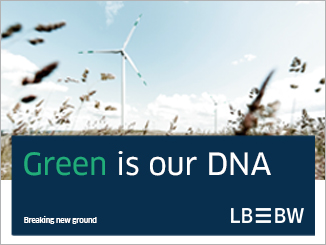The European Stability Mechanism is ready to issue social bonds for the first time should any euro area member state apply for Pandemic Crisis Support under a €540bn EU safety net. ESM head of funding and investor relations Siegfried Ruhl spoke to Sustainabonds’ Neil Day about how the instrument befits its latest role and builds on its broader ESG efforts.

You can also download a pdf of the interview here.
Neil Day, Sustainabonds: How has the ESM’s involvement in the EU Covid-19 response in the form of the Pandemic Crisis Support come about?
Siegfried Ruhl, ESM (pictured above): The ESM is the crisis resolution mechanism with the mandate to safeguard financial stability in the euro area. In the euro crisis 10 years ago, it provided financial assistance to five countries — Ireland, Portugal, Greece, Spain and Cyprus — and disbursed a total of almost €300bn in loans. So when the Covid-19 crisis came to Europe in February, posing unprecedented challenges and a threat to financial stability, it was natural that our member states asked the ESM to be part of the European response to the crisis.
This pandemic crisis is very different from that of 10 years ago. In 2010, five euro area countries lost or risked losing market access because economic policy developments were unsustainable over the long term. Back then, the countries needed loans and time to adjust policies and reform, and they were all successful in overcoming their problems. Today’s Covid-19 crisis affects the entire euro area, Europe, and beyond. It resulted in a tragic loss of life and a lot of economic damage. But the root cause has nothing to do with policy choices by individual governments, so there is no need for further conditions or reforms.
On 9 April, the euro area finance ministers, the so-called Eurogroup, decided on a comprehensive European economic policy response to this Covid-19 crisis. Concretely, three important safety nets were established: for workers, the SURE programme from the European Commission; for SME businesses, a loan guarantee scheme from the European Investment Bank; and for sovereigns, a credit line from the ESM, available to all 19 euro area member states. The three initiatives together amount to a package worth €540bn.
The ESM’s safety net for sovereigns is called Pandemic Crisis Support, and has a volume of up to €240bn. On 23 April, the European heads of state and government endorsed this agreement, and on 8 May, the Eurogroup agreed on the details attached to the ESM credit line. We then had to go through some national procedures and the credit line was made operational by our highest decision-making body, the ESM board of governors, on 15 May.
The Pandemic Crisis Support provided by the ESM is based on the so-called Enhanced Conditions Credit Line — this has been one of the ESM’s instruments since the institution’s creation, but it has never been used. The new Pandemic Crisis Support covers euro area member states’ direct and indirect healthcare cure and prevention-related costs related to this Covid-19 pandemic.
Where does the maximum combined volume of €240bn come from? The idea is that the ESM is able to provide loans of up to 2% of the gross domestic product (GDP) of each euro area country, so should all 19 euro area countries apply and draw from the credit line, we would reach this figure. But we don’t expect that all 19 euro area states will draw. It’s up to each member state to decide whether they want to draw on it or not. And even if a country applies for a credit line, it does not necessarily mean that it’s automatically also drawing on the credit line, so in the end we expect less than the available capacity of €240bn to be requested.
Day, Sustainabonds: Do you have any further clarity or working assumptions on how much might be drawn?
Ruhl, ESM: Ultimately, it is a decision for each member state whether to ask for the Pandemic Crisis Support or not.
If we look at it from a financial perspective, there are currently 12 euro area member states that would benefit from drawing on the credit line, i.e. for whom it would be financially more attractive to fund themselves via this Pandemic Crisis Support than issuing to the market. And if we look at the GDP of these member states, then this would amount to a size of around €90bn.
Day, Sustainabonds: Can you expand on the advantages to countries of turning to the ESM for the Pandemic Crisis Support?
Ruhl, ESM: With the creation of this Pandemic Crisis Support, the euro area member states took a big step.
Firstly, there is only one condition linked to the Pandemic Crisis Support, which is that the funds have to be used to finance direct and indirect healthcare costs related to the Covid-19 situation. This is different to what we did in the past — there are no country-specific measures. Clearly, there is no reason to fear any stigma effect.
But also from a financial perspective, the creation of the Pandemic Crisis Support is a great result of solidarity and cooperation between the euro area member states. This is apparent from the agreed terms and conditions, which are financially very attractive.
We will separate internally the costs of funding for the Pandemic Crisis Support from our outstanding funding. This means the loans and the cost of the loans — which are based on our funding costs — will not be impacted by our outstanding funding, and ultimately this means member states will benefit in full from the current ultra-low and even negative interest rate environment, so we will pass through our low cost of funding.
Another component of the loan rate are fees and margins, and here the member states agreed on very favourable terms. This includes special low rates for the annual margin of only 0.1%, annual service fee of only 0.005%, and the one up-front service fee was halved to 0.25%.
This combination of light conditionality and low funding costs for the new instrument reflects the symmetric nature of the Covid-19 crisis — and we can make this available very quickly once a member state applies. An average maximum maturity of 10 years for the loans was agreed, and if we take a 10 year loan rate for a member state, for example, and look at our own funding costs and add all the fees and margins, the loan rate for the member state would be around 0%. In case we would fund the loans with an average maturity of around seven years, like our current outstanding funding, the loan rate would even be negative. So under current market conditions, for some countries the cost savings of borrowing from the ESM rather than directly from capital markets could be up to €6bn over a 10 year horizon — this is a real cash saving for taxpayers, with less taxpayers’ money needed to cover interest payments to global capital markets.
Day, Sustainabonds: To what extent is this a temporary measure, or could it develop into a longer term change of mission for the ESM, potentially being drawn into other pan-EU support measures?
Ruhl, ESM: The ESM board of governors has given us a very specific role, related to direct and indirect healthcare costs of the pandemic. The support we can provide is solely for euro area member states, and it’s a temporary credit line tailored to the coronavirus crisis.
Member states can apply for the credit line until the end of 2022. Once the Pandemic Crisis Support is approved, it’s available for 12 months, and this availability period can be extended twice by six months, meaning the maximum period under which member states can draw on it is until end of 2024. They can then draw on loans with a maximum average maturity of 10 years. So it’s to some extent temporary, but the loan maturities also give member states sufficient time to recover and ultimately to repay the loans.
Day, Sustainabonds: The support can be drawn at short notice — that must be challenging, given the magnitude versus your otherwise projected funding. How do you plan for that?
Ruhl, ESM: Well, it’s in the nature of our mission that we have to deal with uncertainty, that we have to be able to raise funds in difficult market conditions, and that we have to be able to react quickly — this is how we set up our funding strategy at the beginning, and in the past we have shown that it works quite well. We are present in different markets to access a very broad investor base: we have the bills market, we have the euro bond market, and we have the US dollar market, with liquid benchmark bonds in all parts of the curve. This enabled us in the past and will enable us in the future to raise large volumes in a short period of time, without disrupting our secondary market.
We should also note that the current situation is different from the past: all our member states have market access. This means there is less pressure and urgency for us to raise funding in case the Pandemic Crisis Support is requested.
In addition, there is a clear schedule for the ESM’s obligation to deliver the funds under the Pandemic Crisis Support, and this gives us flexibility around the timing of our funding activities. We could disburse 15% of the applied funds on a monthly basis, so that the full credit line would be provided within seven months. All this ensures that the funding activities can be carried out in an orderly manner.
The full process starts with a country applying for the Pandemic Crisis Support by submitting to the board of governors a pandemic response plan, which details the purposes for which the loan is requested. The application must then be unanimously approved by our board of governors, but this also means — as mentioned — that there is no automaticity that the applicant will draw the credit line.
So far, no country has applied. This means that there has not yet been any impact on our funding activity. Once we receive such a request, we have to amend our funding plan, and of course in line with the requested volumes. We have always communicated transparently about funding needs and we will continue to do so. At the moment, the long term funding needs for the ESM and the sister borrower, the European Financial Stability Facility (EFSF), remain €30.5bn for 2020, and we announced as a forecast for 2021 an amount of €24.5bn. These are the amounts that are needed to roll over our existing debt. Should we receive a request for the Pandemic Crisis Support, this will come in addition to those numbers and would require a change of the funding plan.
Procedure for requesting and granting Pandemic Crisis Support

Source: ESM
Day, Sustainabonds: Why do you feel that social bonds are now an appropriate instrument for the ESM?
Ruhl, ESM: The ESM Pandemic Crisis Support is set up to finance direct and indirect healthcare cure and prevention-related costs due to the Covid-19 crisis. This means it addresses a social issue that severely threatens public health, and at this time the clear definition of the use of proceeds puts us in a position to be able to issue social bonds in line with the requirements of the ICMA Social Bond Principles.
In late June, we published the new ESM social bond framework, so we are now in a position to issue social bonds if a credit line application is successfully made. With this approach, the ESM can make use of social bonds as an innovative debt instrument allowing the investor community to allocate its funds into the social needs of the euro area member states affected by the pandemic crisis. Funding the Pandemic Crisis Support with the issuance of social bonds also underlines the social element of this instrument provided by the ESM.
It is also our objective to support the development of this young market segment. And while at the beginning of this decade, when we were created, financial markets were the reason for the crisis, what is also different now is that financial markets are part of the solution, and the issuance of social bonds highlights that.
But let me mention here that we will of course continue to provide attractive and liquid investment opportunities in our existing instruments. We will not stop issuing our conventional bills and bonds, and we have to roll over our existing debt, which does not qualify for social bonds, so the social bonds will be issued for the Pandemic Crisis Support in addition to that.
Day, Sustainabonds: How broad is the scope of activities under the healthcare heading?
Ruhl, ESM: The eligible social expenditures fall into three categories, as described in the ESM social bond framework. The first category includes costs for healthcare cure and prevention that must be directly related to the Covid-19 pandemic, and thus providing universal access to healthcare services. The second category is that part of overall public healthcare spending estimated to be directly or indirectly attributed to addressing the impact of Covid-19 on the healthcare system’s ability to ensure the continued supply of basic goods and services to the population. And then under the third category are other indirect costs related to healthcare cure and prevention due to the Covid-19 crisis.
Day, Sustainabonds: Will countries be reporting on the “use of proceeds”? How does that play into any reporting you will be doing?
Ruhl, ESM: The ESM will work with the European Commission and also the European Central Bank on the monitoring of the use of funds based on regular reporting by the beneficiary member states. Based on this, the ESM will report on the allocation and impact of the net proceeds raised by the social bonds, on the eligible social expenditures made by the beneficiary member states. To keep our investor base informed, the ESM will within a year of issuance of the first ESM social bond publish a report, and then every year thereafter, until the allocation is complete. As recommended in the Social Bond Principles reporting guidance, this report will describe all social bonds issued and eligible social loans outstanding. We will make this ESM social bond reporting available on our ESM website.
Day, Sustainabonds: How useful are the Social Bond Principles in helping the direction of your efforts?
Ruhl, ESM: The Social Bond Principles of ICMA set the highest market standard for social bonds, and we are happy that we were able to create a social bond framework fully aligned with the latest version of these principles — they were updated just two weeks ago, and our social bond framework already complies with this update. Our investors told us that it is important for them that the social bonds are in line with the Social Bond Principles, that this is what they require. So ESM social bonds have the potential to achieve a deeper and broader investor base, which will ultimately help us provide attractive loans to our member states.
Day, Sustainabonds: So are you now ready to go if someone wants to draw on a credit line?
Ruhl, ESM: The publication of the social bond framework in compliance with the Social Bond Principles from ICMA was the last step, and we stand ready to issue social bonds. The social bond framework is published, and also the second party opinion from an environment, social and governance evaluation firm is available, so we are ready to act. Now, when a euro area member state applies for and wants to draw on the Pandemic Crisis Support from the ESM, we can support the loan by the issuance of social bonds in addition to our conventional bonds and bills.
Day, Sustainabonds: You mentioned the deeper investor base for social bonds would help you provide attractive funding to the member states — do you envisage there being a pricing difference versus your other issuance for the social bonds?
Ruhl, ESM: The starting point for the pricing of the social bonds is, of course, our liquid outstanding curve of ESM bonds and bills. From a credit perspective, there is no difference between the conventional ESM bonds and ESM bonds issued under the social bond framework. Social bonds issued by the ESM will have the same top rating and credit risk as our conventional bonds — ESM’s long term ratings are AAA stable outlook from Fitch and Aa1 stable outlook from Moody’s.
 The ESM social bond framework may make the social bonds more attractive for some of our investors or even bring new investors to our books. So there is a possibility that the ESM social bonds could offer a cost advantage, yet it’s a bit too early to say — ultimately this needs to be seen once we are issuing social bonds and they are traded in the market.
The ESM social bond framework may make the social bonds more attractive for some of our investors or even bring new investors to our books. So there is a possibility that the ESM social bonds could offer a cost advantage, yet it’s a bit too early to say — ultimately this needs to be seen once we are issuing social bonds and they are traded in the market.
Day, Sustainabonds: If the social bonds are linked to your crisis role, does this mean you would not issue social bonds if Pandemic Crisis Support is not drawn?
Ruhl, ESM: This is correct. The use of proceeds as outlined in our social bond framework is entirely Covid-19-related. This means there is no social bond issuance if no drawdowns on the Pandemic Crisis Support credit lines happen.
Day, Sustainabonds: Your potential issuance of social bonds is drawing interest now, but what moves had you taken in the ESG field before the crisis and why?
Ruhl, ESM: The ESM has been active on ESG-related topics during the past few years. As an international financial institution with a public mandate, the ESM believes that embedding ESG best practices across our institutional activities will contribute towards better and more sustainable outcomes within the ESM’s internal operations as well as for our funding and investment activities.
Regarding our internal operations, we have made significant efforts to reduce the institution’s environmental impact and to ensure that internal policies and practices are in line with best practice standards. The ESM’s governance practices are based on transparency and accountability. In this context, the ESM has signed up to a range of ESG initiatives, such as the Zero Single-Use Plastic manifesto, through which we have committed to eliminate single-use plastics across the institution by the end of 2020.
On the investment side we are also looking at this — the ESM became a signatory of the United Nations Principles for Responsible Investment (UN PRI) in February of this year. We have chosen to apply the UN PRI to all our invested capital. Already since 2014, the ESM has been involved in the green bond market, with the intention of supporting the development of sustainable investments. The ESM therefore allocates capital to green bonds, when the characteristics and the interest rate of issued securities are in line with Article 22 of the ESM treaty and with the ESM’s investment objectives and guidelines.
The ESG focus of our annual report published in June is another testimonial of our commitment to this topic.
Coming back to funding, the recently-announced social bond framework is hence just another step in this direction. We have already been actively engaged in the market ecosystem, establishing guidelines for the social bond market and being an observer in the ICMA social bond working group and a member of the advisory council. So the ESM social bonds will be a further element, building on the ESM’s efforts in the ESG space.
Day, Sustainabonds: Is there a potential for the ESM to issue green bonds?
Ruhl, ESM: The use of our proceeds has to align with the scope of our mandate as defined by our governing bodies, and our mandate relates to financial assistance for countries in distress. As such, we cannot issue green bonds.
However, we look closely into this topic on the investment side. In 2019 we invested more than €1bn of the paid-in capital in green and social bonds as per ICMA’s definitions. That was more than double the previous year’s allocation.
Sustainabonds conducts all research and writing independently to maintain the full editorial integrity of the publication.
As a supporter of Sustainabonds, LBBW is facilitating a series of interviews with leading players in ESG and the green, social and sustainability bond markets.
Photo credit: Siegfried Ruhl and ESM building – ESM/Steve Eastwood




